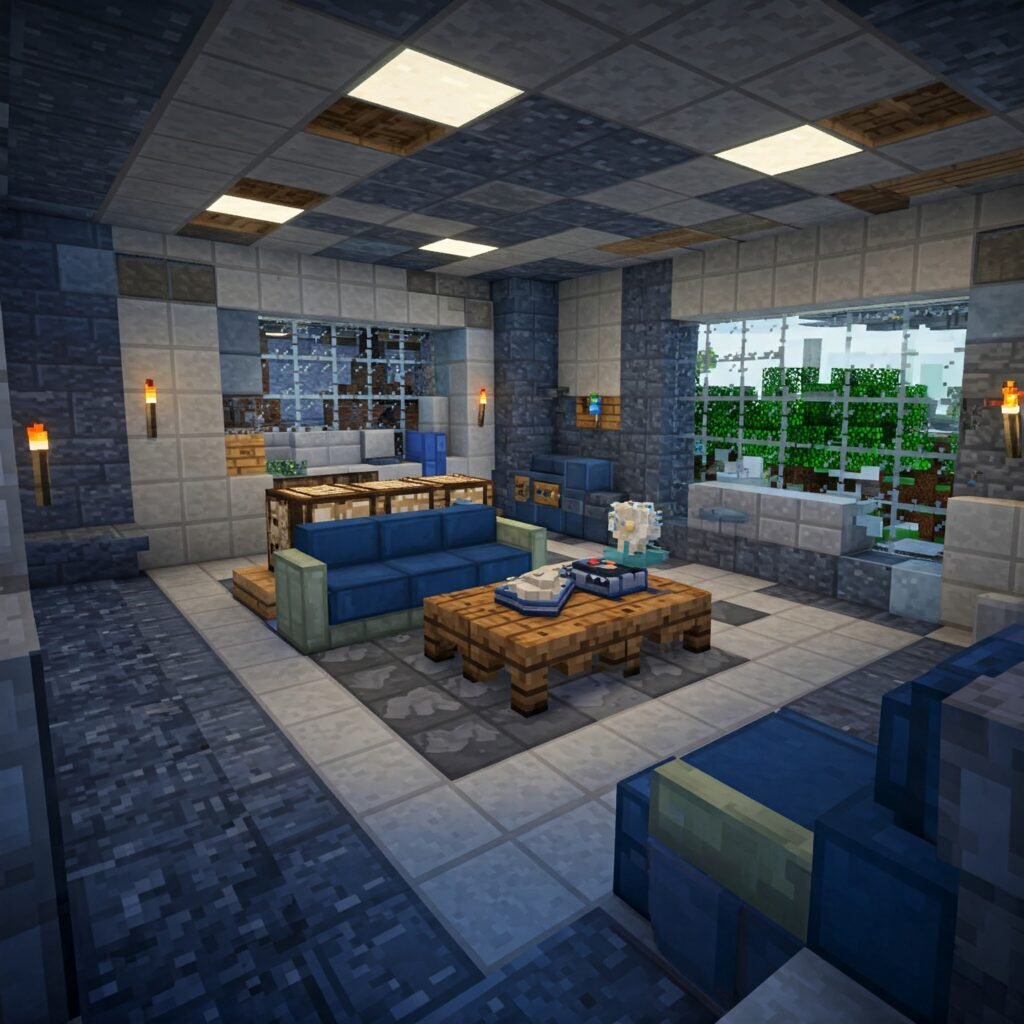Minecraft interior design is what transforms empty structures into breathtaking, lived-in spaces. Whether you’re furnishing a survival base or creating an artistic masterpiece, mastering interior design techniques will elevate your builds from ordinary to extraordinary.
This ultimate guide reveals 17 professional strategies for creating stunning Minecraft interiors. From fundamental principles to advanced detailing tricks, you’ll learn how to design spaces that are both visually impressive and perfectly functional.
1. Essential Block Selection for Minecraft Interior Design
Your material choices set the entire tone for your interior:
- Wood types (Oak for brightness, Dark Oak for richness)
- Stone variants (Andesite for texture, Blackstone for drama)
- Modern materials (Quartz, Concrete, Terracotta)
- Decorative blocks (Glazed terracotta patterns, Wool accents)
Expert tip: Create a 3-block material palette (primary, secondary, accent) for cohesive designs.
2. Living Room Layouts in Minecraft Interior Design
Design principles for perfect gathering spaces:
- Furniture scaling (2-block deep sofas using stairs)
- Focal points (Fireplaces, picture windows)
- Traffic flow (Maintain 1.5 block walkways)
- Lighting layers (Overhead + task + accent lighting)
Pro technique: Use armor stands with leather armor as throw pillows on sectionals.
3. Kitchen Functionality in Minecraft Interior Design
Cooking spaces require smart planning:
- Work triangle (Stove, sink, storage placement)
- Appliance builds (Smokers as ovens, Cauldrons as sinks)
- Storage solutions (Barrel pantries, labeled chests)
- Counter materials (Polished diorite for marble looks)
Modern touch: Create open shelving using iron bars as brackets.
4. Bedroom Design Psychology
Restful retreats need:
- Proper scaling (3×3 minimum for single beds)
- Mood lighting (Redstone lamps on daylight sensors)
- Storage integration (Chests disguised as bed frames)
- Personal touches (Item frame displays)
Luxury option: Build canopy beds using banners and chains.
5. Bathroom Realism Techniques
Essential wet room elements:
- Shower stalls (Waterlogged stairs with glass partitions)
- Vanity areas (Mirrors using glass pane tricks)
- Plumbing illusions (Dispenser faucets)
- Tile patterns (Alternating glazed terracotta)
Spa upgrade: Add steam effects using campfires under glass.
6. Home Office Productivity
Functional workspaces require:
- Ergonomic layouts (Proper desk-to-chair heights)
- Organization systems (Lectern planners)
- Tech setups (Redstone computers)
- Inspiration walls (Map art displays)
Executive touch: Use armor stands as stylish office chairs.

7. Secret Room Mechanics
Hidden spaces add excitement:
- Concealed entries (Painting doors, bookshelf switches)
- Redstone tricks (Piston staircases)
- Security features (Combination locks)
- Functional hides (Emergency supply caches)
Creative idea: Build a panic room with shulker box storage.
8. Outdoor Living Spaces
Seamless indoor/outdoor flow:
- Transition areas (Covered patios)
- Natural elements (Water features, gardens)
- Entertainment zones (Fire pits, seating areas)
- Lighting schemes (Path lights, hanging lanterns)
Pro tip: Use campfire smoke for cozy evening ambiance.
9. Thematic Design Systems
Strong visual storytelling through:
- Historical styles (Medieval, Victorian)
- Cultural influences (Japanese, Mediterranean)
- Concept themes (Steampunk, Futuristic)
- Environmental (Underwater, Treehouse)
Research tip: Study real architecture photos for authentic details.
10. Advanced Lighting Strategies
Lighting affects both function and mood:
- Three-point systems (Key, fill, backlight)
- Hidden sources (Glowstone under carpets)
- Dynamic controls (Daylight sensor automation)
- Accent lighting (Highlighting architectural features)
Technical trick: Use light blocks for invisible illumination.
11. Custom Furniture Engineering
Creative problem-solving for:
- Modular pieces (Reconfigurable shelving)
- Transformable items (Desk-to-bed conversions)
- Textural details (Fabric drapes, cushions)
- Proper scaling (Human proportion guidelines)
Building hack: Use barrier blocks for floating elements.
12. Architectural Detailing
Fine touches that sell realism:
- Crown molding (Stair/slab combinations)
- Wainscoting (Lower wall treatments)
- Ceiling features (Beams, coffered designs)
- Floor transitions (Border patterns, rug defines)
Detail secret: Intentional imperfections add character.
13. Smart Storage Solutions
Organization maintains aesthetics:
- Categorization systems (Color-coded areas)
- Hidden compartments (False walls, floor hatches)
- Display storage (Visible but organized)
- Compact solutions (Staircase drawers)
Storage hack: Renamed item frames as invisible labels.
14. Professional Building Methods
Advanced construction techniques:
- Forced perspective (Size illusions)
- Material gradients (Gradual transitions)
- Negative space (Strategic emptiness)
- Focal points (Visual centerpieces)
Master approach: Design interiors first, then exteriors.
15. Common Mistakes and Fixes
Avoid these frequent errors:
- Overcrowding (Maintain clear circulation)
- Lighting neglect (Prevent mob spawns)
- Theme inconsistency (Establish style rules)
- Ignoring function (Practical survival needs)
Debugging trick: Review screenshots to spot flaws.
16. Color Theory Applications
Strategic color use enhances:
- Mood creation (Warm vs cool palettes)
- Space perception (Dark for intimacy, light for openness)
- Visual flow (Transitioning hues between rooms)
- Accent strategies (10-20% pops of contrast)
Pro tip: Use concrete powder for softer color variations.
17. Inspiration and Innovation
Continual improvement through:
- Real-world study (Architectural references)
- Community inspiration (Builder showcases)
- Personal challenges (Theme limitations)
- Technical experimentation (New block uses)
Growth mindset: Every build teaches something new.
Final Thoughts
Mastering Minecraft interior design is a journey of creative discovery. As you implement these 17 professional techniques:
- Start with strong foundations (block selection, layout)
- Layer in functionality (storage, lighting)
- Add artistic details (textures, accents)
- Polish with realism (imperfections, lived-in touches)
Your builds will transform from simple structures into breathtaking spaces that tell stories and inspire others. What interior design challenge will you conquer next?
